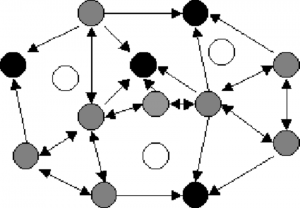Metapopulation Dynamics is different in both form and function from all the previous readings we’ve done in Ecological Thought and Practice. Rather than perform an experiment and explain the results, as Paine, Connell, Lubchenco and Menge, and MacArthur did, or speak to the ideas and terms used in ecological thought as Clements, Tansley, and Gleason did, Hanski instead provided arguments for a way of predicting the behavior and trends of species in a region.
While I was reading Metapopulation Dynamics I had to revise the way I thought about a metapopulation. Initially, I thought of fish in ponds; the same species may be in several ponds. While each pond has its own population, they could also be observed as a whole and studied as a metapopulation. This conceptualization fell apart when Hanski began speaking about colonization. A species of fish colonizing a pond that wasn’t already connected to their own pond wasn’t helpful to me. Hanski also mentions pathogens as an example. If I have the flu, I have a population of influenza virus cells in my body. Considered with others with the same virus, the virus could be studied as a metapopulation. Colonization would take place, for example, if I sneezed and the virus landed on a surface. The virus cells may get into a healthy person and infect them, thereby colonizing another suitable space, or it might die before it colonizes, a risk of migration. Ultimately, after working through both of these, it helped me understand the example Hanski used, the Glanville Fritillary butterfly.
Hanski spends a good deal of time explaining how metapopulation dynamics can be used to predict a species’ persistence. I can’t explain any of the equations used, but when factoring the area of separate “patches” of populations, distance of the patches from one another, time, population density of patches, total number of patches, and other factors, one ought to be able to predict the persistence or tendency toward extinction of a metapopulation. In this essay, I take patch to be a region of what MacArthur would call “suitable space”
There are a few, perhaps pedantic, issues I had with this essay. I don’t understand why, as Hanski says on page 42, why “for long-term metapopulation persistence the expected number of new populations generated by one existing population during its lifetime in an otherwise empty patch network must be greater than one.” Would replacement not be persistence? I understand that stochasticity leads to unforeseen events which could lead to the destruction of a single population, but if that group has already replaced itself with another colony elsewhere, the species should persist. This sort of made me think of Zeno’s arrow, but I’m not sure how useful of a tool that is, considering Zeno was a philosopher and Hanski was using math.
In the last few paragraphs of the article, Hanski advocates for conservation in what seemed to me to be an emotional appeal to others. I highlighted the sentences, “We do not know which fraction of currently endangered populations and species are already committed to metapopulation extinction in their present environments. A real worry is that such ‘living dead’ populations and species are numerous, especially because the delay in reaching the new equilibrium is particularly ling in just those cases that matter most, where the new equilibrium is metapopulation extinction.” This type of appeal is new to me in academic writing. I appreciate that he voiced it though. Studying and understanding the environment is interesting but ultimately useless if that information isn’t applied to the preservation of life on earth.
